COSMOSIM®:Radar・Sensor Simulation Framework
OTSL Inc. announced to have completed whole sensor (millimeter wave RADAR/LIDAR/Camera/Infrared&μBolometer image Sensor/Ultrasonic sensor) simulator for Automotive sensor simulations, and also can provide 3DCG MAP for specific radar which has millmeter accurany. We just start to provide COSMOSIM® Framework which include AMMWR/ALR/ACIS/AIRB/AUS/AHDMAP to the following figure.

1. AMMWR : Advanced Millimeter Wave Radar simulator
AMMWR is World’s First Real-time radar simulator with High precision & dedicated 3DCG MAP. Conventional EM solver with Ray trace method can only simulate “Static”, but we use EPIC Games Unreal EngineTM so that we can realize dynamic simulation with real-time.
AMMWR is based on Actual Radar Hardware. Using AMMWR, customer can simulate precise mm-Wave radar using virtual scenario for Autonomouse Vehicle simulation, and more AMMWR can development of high-level recognition, and signal processing algorithm.
【Features】
- Real-Time simulation using 3DCG MAP
- Support FCM/FMCW/Pulse Compression Radar (Frequency: 24/77/79 GHz)
- 300fps speed for FMCW radar dynamic simulation
- Radar Map Viewer (Power, Distance, Vlocity)
- Various Detection Algorithm (MUSIC, 3D-FFT…)
- Window functions for FFT
- Multi-path: able to simulate up to N=5 (transmission, refraction, reflection)
- Ray tracing visualization
【New Features】
- Support RTX GPU for real-time ray trace (UE4.22 later), and speed-up 10 times over
- MIMO Antenna (Tx/Rx)
- 4D-FFT (Range-Doppler, Range-Azimuth, Range-Elevation)
- Extended Kalman Filter (EKF)/ Unscented Kalman Filter (UKF)
- 3D point cloud output using EKF/UKF tracking
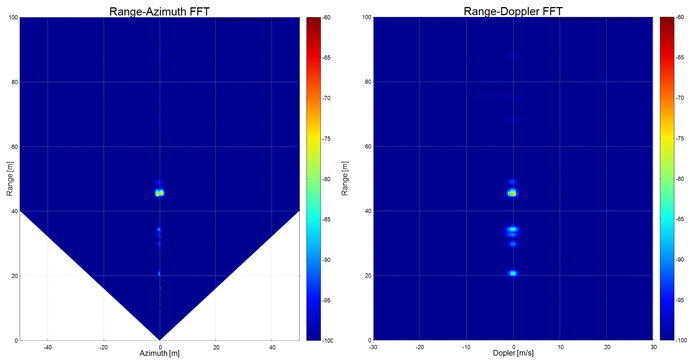
【AMMWR Range-Azimuth, Range-Doppler】
【AMMWR EURONCAP Car to Bicyclist】
2. ALR : Advanced Laser Radar/LIDAR Simulator
ALR has dedicated reflection model and dedicated 3DCG MAP has reflectivity for near infrared laser, so it is possible to accurately simulate the material and color characteristics of the object irradiated with LIDAR laser. By reflection model and reflectivity 2 features, ALR can simulate higher accuracy than common LIDAR simulator.
【Features】
- Real-time simulation using 3DCG MAP
- 3D Point Cloud (Power, depth)
- Support various LIDAR (i.e. Mechanical Scan, MEMS, FLASH LIDAR)
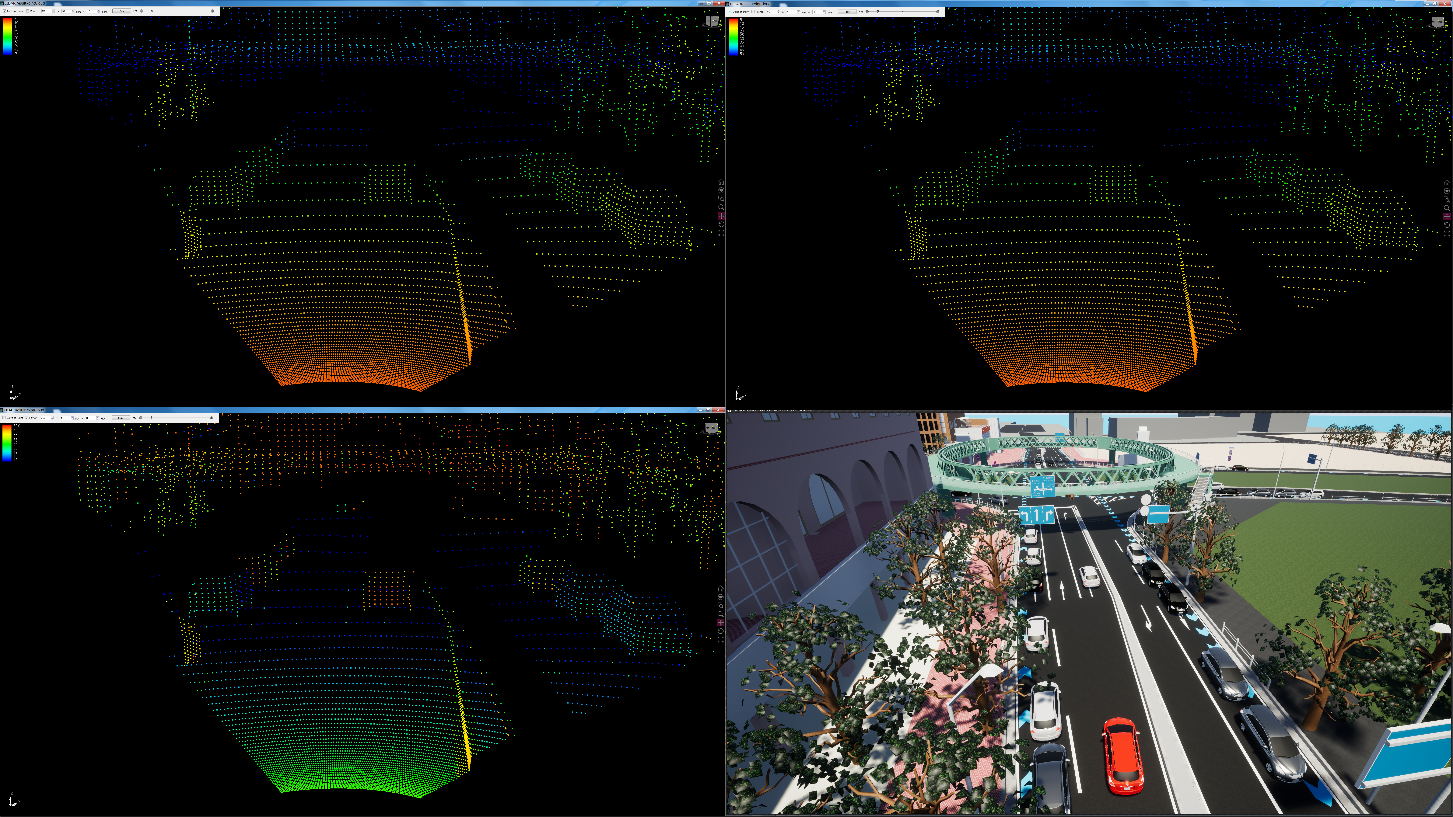
【3DCG LIDAR Simulation (Mechanical Scan type)】
3. ACIS:Advanced Camera/Image Sensor Simulator
ACIS can simulate with extremely high precision, because it corrects the optical aberration of the camera, and it implements the calibration data on ACIS using the actual camera. ACIS also can create easily autonomous driving scenario such as using weather change, sensor post processing Semantic Segmentation, deep learning by cooperating with open source AirSIM (Microsoft) and CARLA Simulator (CVC: computer vision center & MIT source code).

【Features】
- Support Camera types: Fisheye Camera, Monocular Camera, Stereo Camera
- Functions of installed CARLA Simulator
- The lens simulation*: the exact blur, parallax and halation
- By the lens and AR coat simulation, enable accurate ghost reproduction
- Able to simulate with simultaneous simulation with another sensor simulator of COSMOSIM®
* Correspond by the next Version: will be released 2018 December preliminary
4. AIRB:Advanced Infrared/μBolometer Sensor Simulator
AIRB Simulator is the World’s First 3D Real-time sensor simulator for Infrared/μBolometer sensor for autonomous driving simulation. Material data is created from molecular structure, absorption spectrum is calculated by molecular simulation, and then thermal radiation by blackbody radiation model of all objects is calculated to obtain infrared image. Considering temperature rise of the object due to radiation energy such as the sun, AIRB simulation can be executed in real-time on OTSL’s high precision 3D CG MAP.
【Features】
- Support customize IR camera model
- Dedicated 3D CG Map (Accuracy is less than 2mm)
- Able to select arbitrary wavelengths range (e.g. 3-5μm)
- Able to colorize IR picture (using RGB filter)
- Able to calibrate Camera distortion (see ACIS features)
- Simultaneous simulation with Multiple AIRB/others
- Output of images according to the sensitivity band of the sensor (e.g. 2μm-5μm etc.)
- Radiation model for each object, heat storage, latent heat etc.
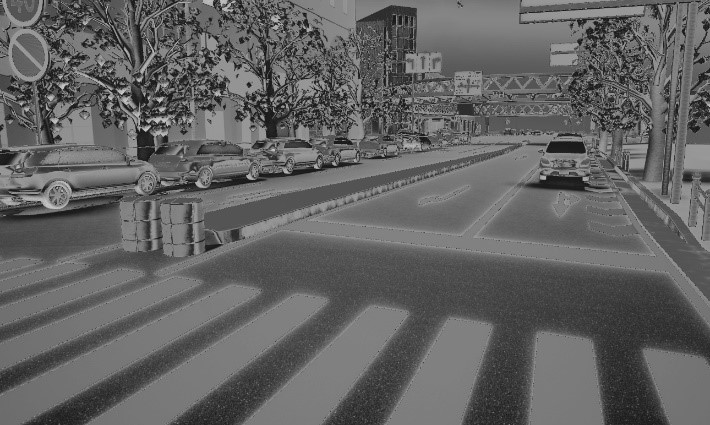
* Specifications subject to change without notice.
* MolView and The MolView Project are copyright of Herman Bergwerf.
* Firefly is copyright of Alex A. Granovsky, Lyndsey Vernon, Chemistry, University of Liverpool.
5. AUS: Advanced Ultrasonic Sensor Simulator
AUS can simulate the Real-time ultrasonic simulation by the high-speed engine with a high precision 3DCG MAP. In addition, AUS can analyze using the Full-wave solver* by the conventional method (there is no Real-time guarantee). Simulation in combination with other sensors enables sensor optimization of the original detection limit and sensor arrangement.
【Features】
- In addition to a microphone sensor of a common piezoelectric element, ACIS can simulate microphone array (using beam forming)
- Sensor directivity of the possible input (bottom right)
- Interference simulation by multiple sensors (Full-wave*)
- Able to simulate with simultaneous simulation with another sensor simulator of COSMOSIM®
* Correspond by the next Version: will be released 2018 December preliminary

6. AHDMAP: Advanced 3DCG High Definition MAP
AHDMAP is high precision 3DCG MAP for RADAR, LIDAR, Infrared/μBolometer sensor and Ultrasonic sensor. This Map’s accuracy is less than 2mm for each material on 3DCG MAP, so COSMOSIM® can simulate more accurate simulation for sensor simulation, development of various detection algorithm and autonomous driving simulation.
【Support 3DCG MAP】
- Yokohama Akarenga (default map)
- Detroit Highway
- Tokyo Metropolitan Highway C1 (both ways)
- Pittsburg Airport to downton (plan)
- ASK (if necessary)
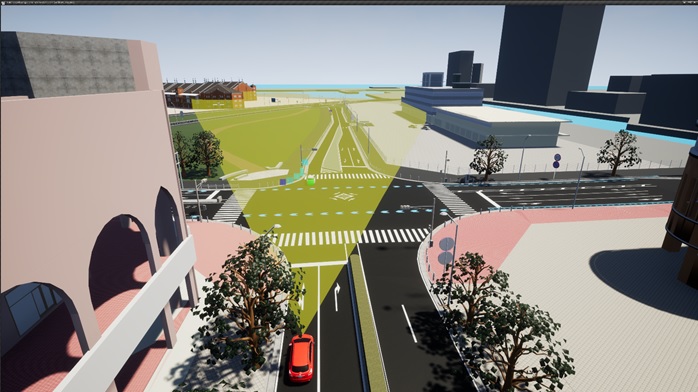
【Yokohama Akarenga 3DCG MAP(Yellow:FOV of Front radar, Red Vehicle : with Radar)】
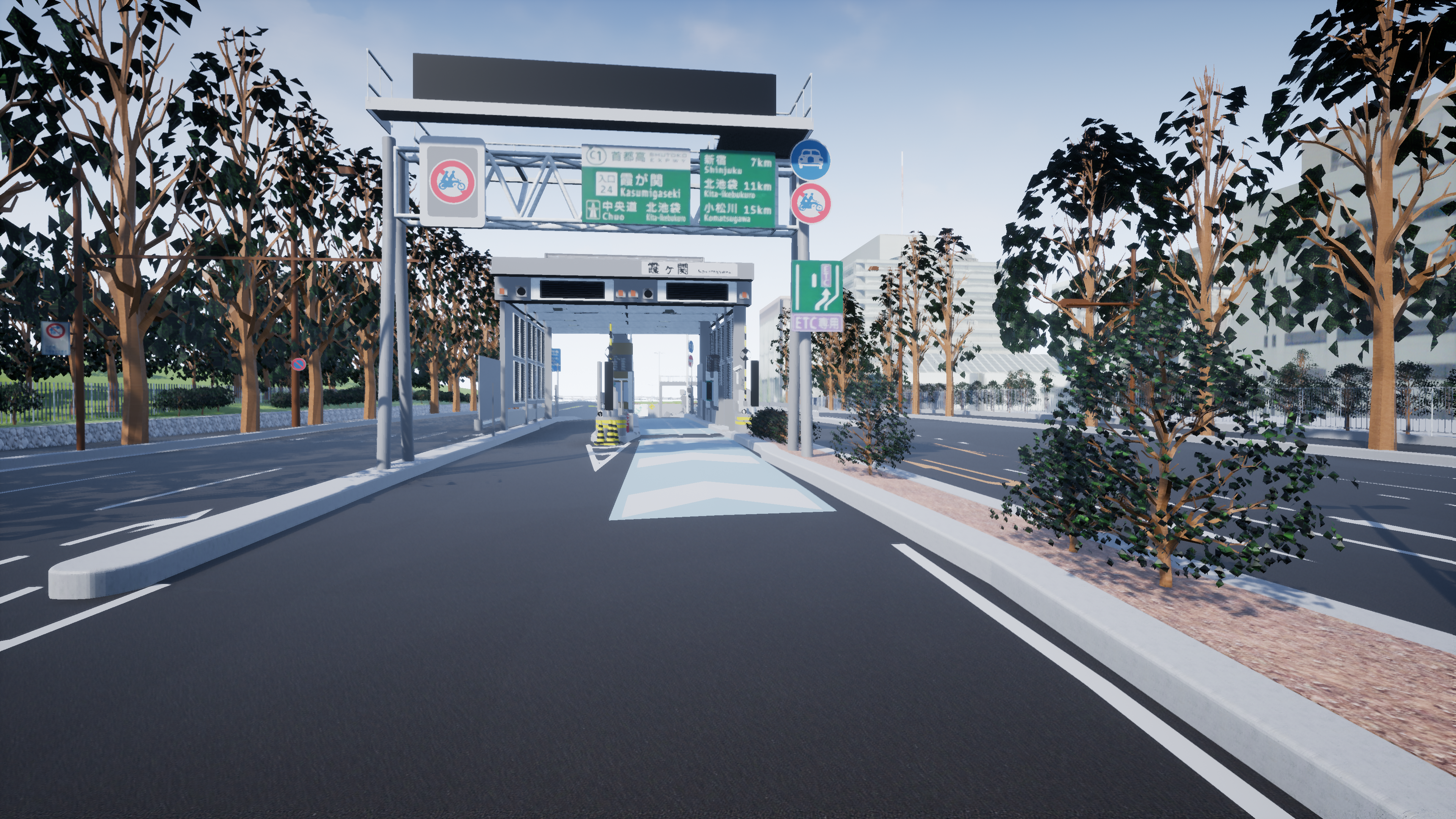
【Tokyo Metropolitan Highway C1 (Kasumigaseki IC)】
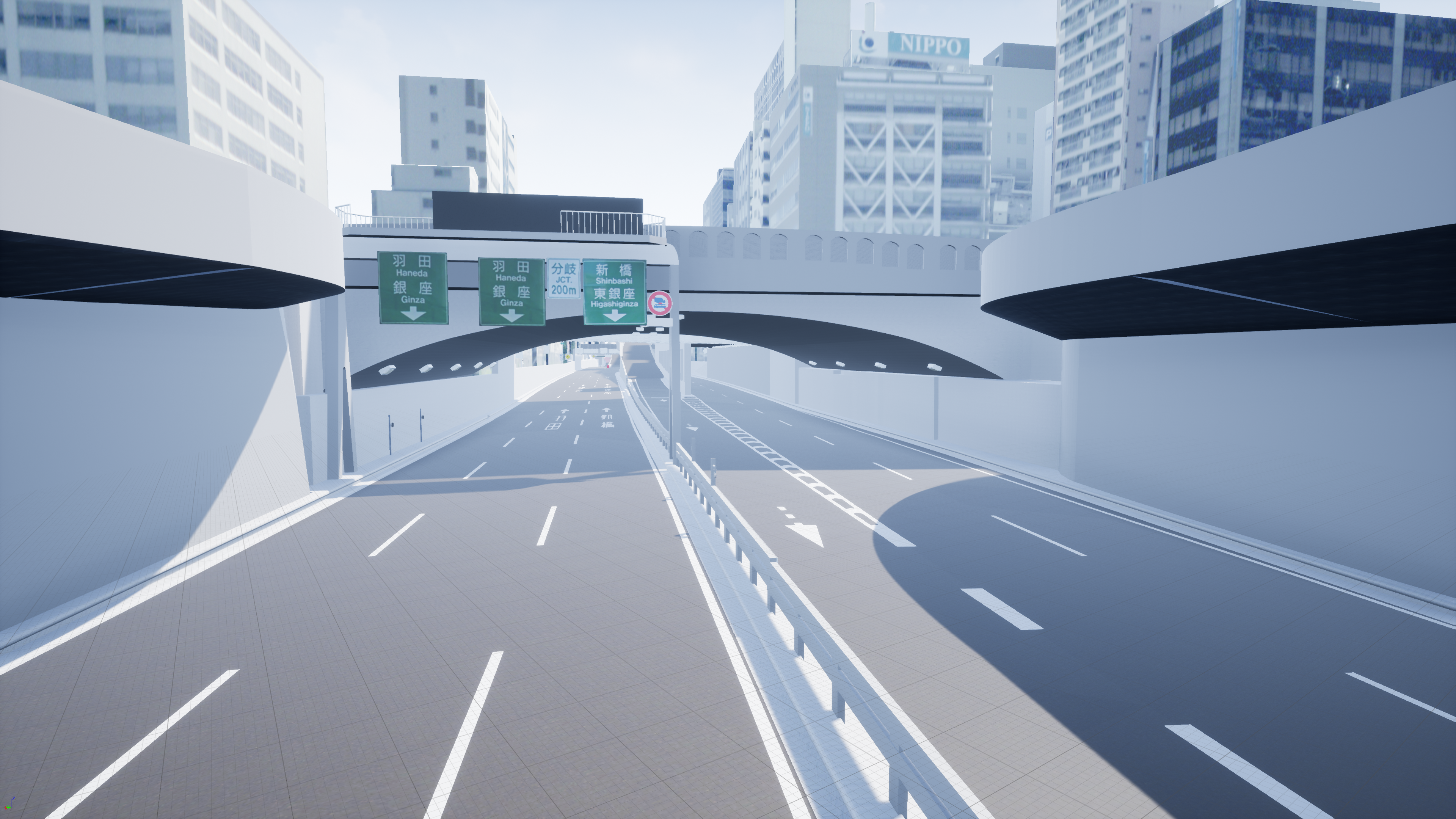
【Tokyo Metropolitan Highway C1 (near Kyobashi JCT)】
■Collaboration with our partners
■CarSIM
Enable simulation of Vehicle dynamics can cooperate with COSMOSIM® in cooperation with CarSIM of Mechanical simulation company.
■COSIDE®
Able to simulate MILS / SILS, which utilizes SystemC AMS CODISE® developed by COSEDA Technologies, which spin-out rom Franhofer EAS/IIS in Germany in 2015 and utilizing software assets at higher speed than before.
■rFpro
rFpro provides the world’s highest precision high-resoluton 3DCG map and its related software through rFpro products sales, we collaborae with rFpro for integration our AMMWR/ALR with rFpro software, have plan to provide more accurate millimeter wave radar and LIDAR simulation environment in the near future.
■RoadRunner®
VectorZero RoadRunner® for Windows and Linux allows anyone to create realistic roads, environments, and props easily. RoadRunner® generates complex road networks incorporating roundabouts, intersections and brodges, custonizes signage, marking, and props, then publishes to many standard simulators and game engines.
■AILiveSim
AILiveSim Oy, Finland, is a finish start-up that leverages gaming technology and machine learning to create a new generation of simulation of dedicated solely to autonomous vehicles. AILiveSim supports a variety of applications, domains and use cases, like creating data sets, training algorithms, automated tests or technical sales support demos to just name a few. The platform is easy to access making it ideal for development teams as well as non-technical team, allowing to rapid iteration from prototyping to market validation.
■HW/SW requirements
OS:Microsoft Windows 10 Professional 64bit
CPU:Intel Core Xeon Multi CPU recommended
GPU:NVIDIA Quadro Series, Quadro RTX (highly recommended)
UE4:Unreal Engine version 4.16 (COSMOSIM® will be compatible with UE4.22 from the end of August)
Products movies (on YouTube):
https://www.youtube.com/channel/UCbwDUjairsHpMzCI9ZUB2ow/videos
We received the following comments regarding our simulator from Professor Emeritus Matsuzawa in Tokyo Institute of technology.
“In order to realize autonomous driving, millimeter wave radars, laser radars, image sensors and ultrasonic sensors are indispensable. It is required to confirm that the developed sensors can operate properly under various situations.
Ultimately, field testing is necessary. But in the development of devices and systems, the real-time simulator is indispensable for improving the efficiency of development. This real-time radar simulator uses Ray-tracing method that has been used in optical field and applies it to the millimeter waves. It takes into consideration the substance and shape of the subject, and multiple reflections. It realizes a precise simulation being closer to reality.”
Akira Matsuzawa received B.S., M.S., and Ph. D. degrees in electronics engineering from Tohoku University, Sendai, Japan, in 1976, 1978, and 1997 respectively. In 1978, he joined Matsushita Electric Industrial Co., Ltd (Panasonic). Since then, he has been working on research and development of analog and Mixed Signal integrated circuit design. From 1997 to 2003, he was a general manager in advanced LSI technology development center. On April 2003, he joined Tokyo Institute of Technology as full professor and now he is full professor, chair of Electrical and Electronic Engineering, and director for Center for Teaching and learning. He is currently researching in mixed signal technologies and RF CMOS integrated circuit design. He is an IEEE Fellow since 2002.

NOTE( logo and trademark ):
Microsoft®, Windows®, Windows NT®, Windows Server® and Windows VistaTM are either registered trademarks or trademarks of Microsoft Corporation in the United States and/or other countries.
3D XPoint, ACEX, Altera, APEX, AnyWAN, Arria, the Arria logo, Axxia, BlueMoon, BunnyPeople, Celeron, Centrino, Cilk, Curie, Cyclone, the Cyclone logo, Docea, Enpirion, Flexpipe, freeD, Hyperflex, Intel, the Intel logo, Intel Atom, Intel CoFluent, Intel Core, Intel Euclid, Intel. Experience What’s Inside, the Intel. Experience What’s Inside logo, Intel Falcon, Intel GO, Intel Inside, the Intel Inside logo, Intel Joule, Intel Nervana, Intel Optane, Intel RealSense, Intel Shooting Star, Intel SingleDriver, Intel SpeedStep, Intel Unite, Intel vPro, Intel Xeon Phi, Intel XScale, InTru, Itanium, MAX, MCS, MMX, Movidius, Myriad, Nios, Ostro, Pentium, picoArray, Picochip, picoXcell, Puma, Quark, Quartus, Saffron, SMARTi, SoftSilicon, Soletta, Sound Mark, StarPro, Stratix, the Stratix logo, Stay With It, the Engineering Stay With It logo, StreamSight, The Journey Inside, Thunderbolt, the Thunderbolt logo, Transcede, Ultrabook, VTune, Xeon, X-GOLD, XMM, X-PMU and XPOSYS are trademarks of Intel Corporation or its subsidiaries in the U.S. and/or other countries.
NVIDIA, the NVIDIA logo, 3D Play, 3D Vision, 3D Vision Pro, 4-Plus-1, APEX, CUDA, Dabbler, DirectStylus, DirectTouch, FX Composer, GameStream, Geared For Gaming, GeForce, GeForce Experience, GeForce GTX, GPUDirect, G-SYNC, GRID LINK, GRID vGPU, GRID VGX, IceClear, ICERA, Iray, Jetson, Kepler, Made To Game, Maximus, mental ray, NSIST on NVIDIA, nTersect, NVIDIA AutoWorks, NVIDIA BATTERY BOOST, NVIDIA Business Platform, NVIDIA GameWorks, NVIDIA GPU BOOST, NVIDIA GRID, NVIDIA GRID vGPU, NVIDIA G-SYNC, NVIDIA IndeX, NVIDIA Maximus, NVIDIA Maxwell, NVIDIA nForce, NVIDIA PartnerForce, NVIDIA PureAudio, NVIDIA Scene Graph, NVIDIA SHIELD, NVIDIA SLI Ready, NVIDIA Slide Cover, NVIDIA TXAA, nView, NVLINK, NVS, Optimus, OptiX, Pascal, PGI, PGI Visual Fortran, PhysX, Quadro, Quadro Experience, RealityServer, SceniX, Shadowplay, SHIELD, SLI, SLI-Ready, Surround, Tegra, Tegra NOTE, TegraZone, Tesla, The Way It’s Meant to be Played, TWIMTBP, ULMB, vGPU and Vibrante are trademarks and/or registered trademarks of NVIDIA Corporation in the U.S. and/or other countries. Other company and product names may be trademarks of the respective companies with which they are associated.
Unreal, the circle-U logo and the Powered by Unreal Technology logo are trademarks or registered trademarks of Epic Games, Inc. in the United States and elsewhere.
